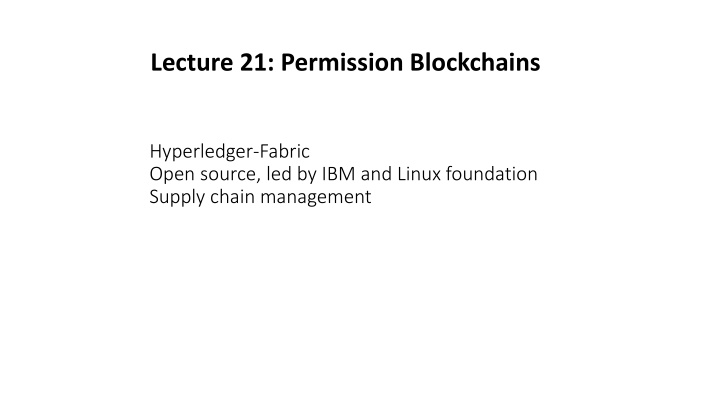
Permissioned Blockchains in Hyperledger Fabric
Explore the concept of permissioned blockchains in Hyperledger Fabric, led by IBM and Linux Foundation, focusing on supply chain management. Discover the importance, advantages, and limitations of permissioned blockchains in the context of blockchain technology.
Download Presentation

Please find below an Image/Link to download the presentation.
The content on the website is provided AS IS for your information and personal use only. It may not be sold, licensed, or shared on other websites without obtaining consent from the author. If you encounter any issues during the download, it is possible that the publisher has removed the file from their server.
You are allowed to download the files provided on this website for personal or commercial use, subject to the condition that they are used lawfully. All files are the property of their respective owners.
The content on the website is provided AS IS for your information and personal use only. It may not be sold, licensed, or shared on other websites without obtaining consent from the author.
E N D
Presentation Transcript
Lecture 21: Permission Blockchains Hyperledger-Fabric Open source, led by IBM and Linux foundation Supply chain management
Permissioned blockchain Each node has an identity provided by the Membership Service Provider(MSP) Various level of identities: Trusted to non-trusted Certain tasks are assigned to certain identities Many voting based PoS blockchains can be converted to permissioned blockchains by allowing voting/mining rights to only certain identities Allow only certain identities to mine
Why need a permissioned blockchain Identities on blockchain can be linked to identities in real world Can track misbehavior (like certain DoS attacks) to identities Weaker adversary assumption justified Implications No need for sybil/spam resistance No need for on-chain incentives No need for currency implementation Potentially very efficient and scalable
This lecture: Hyperledger Fabric Modular permissioned blockchain Pluggable consensus Privacy preserving Horizontal compute scaling: not requiring all nodes to execute State Transition function. Main contribution: Order-Execute to Execute-Order-Validate structure
Order-Execute Source:https://arxiv.org/pdf/1801.10228.pdf
Order-execute: Bitcoin State transition function is executed After ordering the block
Limitations of Order-execute (as discussed in paper) Sequential execution can be throttled by a compute heavy state transition Bypassed by transactions paying for execution cost Cannot be done without any native cryptocurrency Non-deterministic code Eg. Map iterator in go Can lead to forks after ordering Need to use limited languages like Solidity Confidentiality in execution
Hyperledger: Execute-Order-validate Source:https://arxiv.org/pdf/1801.10228.pdf
Chaincode and Endorsements Chaincode: smart contract + endorsement policy Smart contract implements the state transition function for an application State created by one Chaincode cannot be accessed by another Chaincode Chaincode can invoke another chaincode Each Chaincode specifies an endorsement policy Eg. Need to collect 4 out of 10 signatures from a list of endorsers Endorsers sign transactions that performs correct execution
State management State is maintained in a versioned key-value store (key, value, version) Each transaction has Readset: (key, value, version) accessed by the transaction Writeset: (key, value, version) changed by the transaction Endorsers sign a transaction along with the readset and writeset
Execution-Phase Peer Tx Endorsement Tx Endorsers Tx TX: A->B: $10 Initial state: A,2:20, B,1:10 Final state: A,3:10, B,2:20 Tx Ordering Service
Ordering Service A set of nodes responsible for consensus Receive transactions with endorsements from peers Orders them through some consensus mechanism Can be Total-order broadcast of transactions Can be any BFT based consensus algorithm Can be Bitcoin like algorithm Do not perform any validation
Validation Performed by all peers Endorsement policy evaluation: Check if the transaction has sufficient endorsements as specified by the Chaincode policy can be done in parallel State update check: Check if the readset uses the correct version of keys and the writeset updates the key version (Sequential, however do not need to perform execution) Local state update: Update the local state (sequential)
Endorsement policy evaluation Example 1: Chaincode A endorsement policy: need 2 of 3 endorsement from endorsers X,Y,Z Chaincode A transaction: Contains endorsement from X,Z: Pass Chaincode A transaction: Contains endorsement from W,X: Fail Chaincode A transaction: Contains endorsement from Y: Fail Example 2: Chaincode B endorsement policy: need endorsement from central bank
State update State update check example: Tx: Readset: (Alice:20,1),(Bob:10,2) , Writeset: (Alice:10,2),(Bob:20,3) Local state: (Alice:20,3), (Bob:10,2) Tx readset does not match with local state: Fail State update: Locally store a validity bitmask TX1 TX2 TX3 TX4 1 0 1 1 Validity bitmask Block
Concurrent execution Each Chaincode can use different set of endorsers Chaincode A Fabric chain Chaincode C Chaincode B = Endorsers
Confidentiality The Chaincode execution code can be made private, only make the chaincode endorsement policy and other metadata public Chaincode A Fabric chain Other endorsers have limited knowledge of Chaincode A s execution
Deterministic execution Random execution won t collect enough endorsements TX: A->B: 9 TX: A->B:U[8,11] Peer Tx Endorsement Tx TX: A->B: 10 Endorsers Tx TX: A->B: 10 Initial state: A,2:20, B,1:10 Final state: A,3:10, B,2:20 Tx TX: A->B: 11 All endorsements are different, No transaction satisfies the endorsement policy TX: A->B: 8
Overview Source:https://arxiv.org/pdf/1801.10228.pdf
Discussion Similarity with sharding Shard validators can be compared to endorser set Zilliqa transaction sharding: Small set of validators sign the validity of transactions(Endorsers) Endorsement submitted to directory shard (Ordering service)
